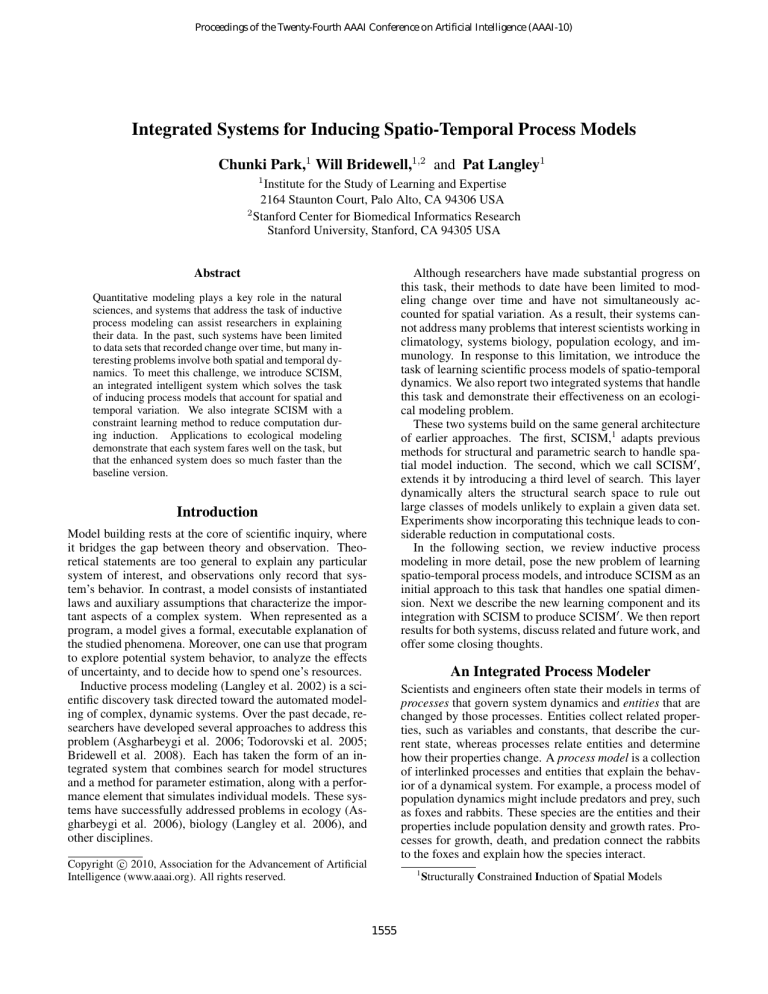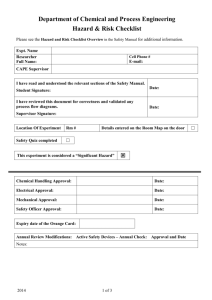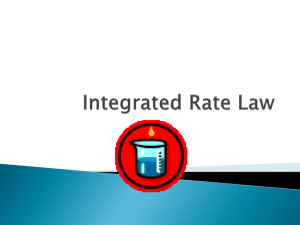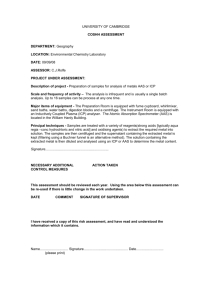
Proceedings of the Twenty-Fourth AAAI Conference on Artificial Intelligence (AAAI-10)
Integrated Systems for Inducing Spatio-Temporal Process Models
Chunki Park,1 Will Bridewell,1,2 and Pat Langley1
1
Institute for the Study of Learning and Expertise
2164 Staunton Court, Palo Alto, CA 94306 USA
2
Stanford Center for Biomedical Informatics Research
Stanford University, Stanford, CA 94305 USA
Abstract
Although researchers have made substantial progress on
this task, their methods to date have been limited to modeling change over time and have not simultaneously accounted for spatial variation. As a result, their systems cannot address many problems that interest scientists working in
climatology, systems biology, population ecology, and immunology. In response to this limitation, we introduce the
task of learning scientific process models of spatio-temporal
dynamics. We also report two integrated systems that handle
this task and demonstrate their effectiveness on an ecological modeling problem.
These two systems build on the same general architecture
of earlier approaches. The first, SCISM,1 adapts previous
methods for structural and parametric search to handle spatial model induction. The second, which we call SCISM0 ,
extends it by introducing a third level of search. This layer
dynamically alters the structural search space to rule out
large classes of models unlikely to explain a given data set.
Experiments show incorporating this technique leads to considerable reduction in computational costs.
In the following section, we review inductive process
modeling in more detail, pose the new problem of learning
spatio-temporal process models, and introduce SCISM as an
initial approach to this task that handles one spatial dimension. Next we describe the new learning component and its
integration with SCISM to produce SCISM0 . We then report
results for both systems, discuss related and future work, and
offer some closing thoughts.
Quantitative modeling plays a key role in the natural
sciences, and systems that address the task of inductive
process modeling can assist researchers in explaining
their data. In the past, such systems have been limited
to data sets that recorded change over time, but many interesting problems involve both spatial and temporal dynamics. To meet this challenge, we introduce SCISM,
an integrated intelligent system which solves the task
of inducing process models that account for spatial and
temporal variation. We also integrate SCISM with a
constraint learning method to reduce computation during induction. Applications to ecological modeling
demonstrate that each system fares well on the task, but
that the enhanced system does so much faster than the
baseline version.
Introduction
Model building rests at the core of scientific inquiry, where
it bridges the gap between theory and observation. Theoretical statements are too general to explain any particular
system of interest, and observations only record that system’s behavior. In contrast, a model consists of instantiated
laws and auxiliary assumptions that characterize the important aspects of a complex system. When represented as a
program, a model gives a formal, executable explanation of
the studied phenomena. Moreover, one can use that program
to explore potential system behavior, to analyze the effects
of uncertainty, and to decide how to spend one’s resources.
Inductive process modeling (Langley et al. 2002) is a scientific discovery task directed toward the automated modeling of complex, dynamic systems. Over the past decade, researchers have developed several approaches to address this
problem (Asgharbeygi et al. 2006; Todorovski et al. 2005;
Bridewell et al. 2008). Each has taken the form of an integrated system that combines search for model structures
and a method for parameter estimation, along with a performance element that simulates individual models. These systems have successfully addressed problems in ecology (Asgharbeygi et al. 2006), biology (Langley et al. 2006), and
other disciplines.
An Integrated Process Modeler
Scientists and engineers often state their models in terms of
processes that govern system dynamics and entities that are
changed by those processes. Entities collect related properties, such as variables and constants, that describe the current state, whereas processes relate entities and determine
how their properties change. A process model is a collection
of interlinked processes and entities that explain the behavior of a dynamical system. For example, a process model of
population dynamics might include predators and prey, such
as foxes and rabbits. These species are the entities and their
properties include population density and growth rates. Processes for growth, death, and predation connect the rabbits
to the foxes and explain how the species interact.
Copyright c 2010, Association for the Advancement of Artificial
Intelligence (www.aaai.org). All rights reserved.
1
1555
Structurally Constrained Induction of Spatial Models
plane. To handle this richer collection of modeling problems, we extended quantitative process models to support
partial differential equations.
Table 1 depicts an example quantitative process model
for an aquatic ecosystem and shows how we extended the
formalism to include PDEs. The model refers to four entities: phytoplankton (phy), zooplankton (zoo), nitrate (nit),
and detritus (det). These entities appear in the first four
processes that define loss due to death of phytoplankton
and zooplankton, the grazing interaction between those two
species, and the uptake of nitrates by phytoplankton. The
last two processes, which include partial derivatives, characterize vertical movement of plankton in the water column.
The processes phy_spatial_dynamics and zoo_spatial_dynamics in Table 1 illustrate our extension to the process
modeling language. To represent spatial dynamics, we let
a process include partial derivatives in its equations as in
d[phy.conc, t, 1] = −0.65 ∗ d[phy.conc, z, 1], which specifies
the concentration of phytoplankton. The independent variables are time, t, and depth, z, with their partial derivatives represented as d[phy.conc, t, 1] for ∂(phy.conc)/∂t and
d[phy.conc, z, 1] for ∂(phy.conc)/∂z . The number ‘1’ inside
brackets indicates a first-order derivative.
The performance task involves simulating a model to produce a trajectory that one can compare to observations. One
component of SCISM carries out this simulation, first transforming the process model into a system of algebraic and
differential equations, and then using numerical methods to
solve the equations. Generating equations involves combining the effects from each process. By default, SCISM adds
these effects, but it can also take their product, maximum, or
minimum according to variable-specific information stored
in the generic entities. Eq. (1) lists the system of equations
built by summing the effects of each process.
Model builders rarely start from scratch. Instead, they rely
on generic structures that are useful across situations. We refer to this background knowledge as a collection of generic
processes and generic entities. These vary across domains
and act as templates for the instantiated components of a
particular process model. The generic processes include entity roles that are filled by specific entities from the modeling
problem and parameters that let them adapt to different scenarios. The generic entities indicate the properties that play
a part in system dynamics.
The task of inductive process modeling (Bridewell et al.
2008) uses this domain knowledge to explain the behavior
of a dynamical system. More specifically, we can state the
task as:
• Given: Generic entities that have properties relevant to the
observed dynamics;
• Given: Generic processes that specify causal relations
among entities using generalized functional forms;
• Given: A set of entities present in the modeled system;
• Given: Observations for the continuous properties of
those entities as they change over time;
• Find: A process model that explains the observed data and
predicts unseen data accurately.
Previous efforts have produced several systems for inductive process modeling that search for quantitative models
to explain temporal dynamics (Asgharbeygi et al. 2006;
Bridewell et al. 2008; Langley et al. 2002). Recent approaches have added structural constraints to the task description as a way to reduce the number of models considered (Todorovski et al. 2005). In this paper, we extend this
task so that it requires explanation of observations for continuous variables as they vary over both time and space. As
we describe later, this requires changes to the model representation, performance element, and learning mechanism.
As the starting point for this research, we use SC-IPM
(Bridewell and Langley 2010), an integrated system that
uses modular constraints to guide process model induction.
In the remainder of this section, we describe SCISM, which
extends SC-IPM to handle the extended task of inducing
process models that account for both temporal variation and
spatial variation in one dimension.
∂P
∂t
∂Z
∂t
∂N
∂t
∂D
∂t
∂P
+ (0.5 − 0.05) ∗ P − 0.15 ∗ Z ,
∂z
∂Z
= −0.75 ∗
+ (0.3 ∗ 0.15 − 0.1) ∗ Z ,
∂z
= −0.65 ∗
(1)
= −0.01 ∗ 0.5 ∗ P ,
= 0.05 ∗ P + (0.1 + (1 − 0.3) ∗ 0.15) ∗ Z ,
where P, Z, N, and D signify phy.conc, zoo.conc, nit.conc,
and det.conc, respectively.
To solve systems of PDEs, SCISM relies on the semidiscrete method (Heath 2001), which discretizes the spatial
dimensions but leaves time continuous. Using this method,
the simulator breaks up each PDE into a set of ODEs whose
solutions approximate those of the original equation. Starting with initial conditions from a data set, SCISM’s simulator solves the ODEs for the second time point. Output from
this step serves as input to solve equations for the third time
point. This procedure iterates until it produces a complete
trajectory that one can analyze or compare to observations.
Quantitative Process Models
As in previous work, SCISM learns quantitative process
models, which encode qualitative structure as a set of processes that contain quantitative forms of algebraic and ordinary differential equations (ODEs). However, modeling
problems often involve a spatial component that affects their
dynamics (e.g., Arrigo et al. 2008; Zador et al. 1994) and
that rely on partial differential equations (PDEs) to capture
this aspect. Unlike ODEs, which are functions of a single
independent variable (e.g., time), PDEs can be functions of
multiple variables and can include partial derivatives taken
with respect to them. This feature lets PDE-based models
explain system dynamics in terms both of time and of spatial variables, such as depth or position on an x–y coordinate
Inducing Quantitative Process Models
Building explanatory models requires background knowledge about the world and phenomena to be explained. In
1556
Table 1: A process model for an aquatic ecosystem.
Table 2: Some generic processes for an aquatic ecosystem.
model Aquatic_Ecosystem
entities : phy, zoo, nit, det
process phy_loss
equations : d[phy.conc, t, 1] = −1 ∗ 0.05 ∗ phy.conc
d[det.conc, t, 1] = 0.05 ∗ phy.conc
process zoo_loss
equations : d[zoo.conc, t, 1] = −1 ∗ 0.1 ∗ zoo.conc
d[det.conc, t, 1] = 0.1 ∗ zoo.conc
process zoo_phy_grazing
equations : d[zoo.conc, t, 1] = 0.3 ∗ 0.15 ∗ zoo.conc
d[det.conc, t, 1] = (1 − 0.3) ∗ 0.15 ∗ zoo.conc
d[phy.conc, t, 1] = −1 ∗ 0.15 ∗ zoo.conc
process nit_uptake
equations : d[phy.conc, t, 1] = 0.5 ∗ phy.conc
d[nit.conc, t, 1] = −1 ∗ 0.01 ∗ 0.5 ∗ phy.conc
process phy_spatial_dynamics
equations : d[phy.conc, t, 1] = −0.65 ∗ d[phy.conc, z, 1]
process zoo_spatial_dynamics
equations : d[zoo.conc, t, 1] = −0.75 ∗ d[zoo.conc, z, 1]
generic process exponential_loss
entities : S{species}, D{detritus}
parameters : α[0, 1]
equations : d[S.conc, t, 1] = −1 ∗ α ∗ S.conc
d[D.conc, t, 1] = α ∗ S.conc
generic process grazing
entities : S1{species}, S2{species}, D{detritus}
parameters : ρ[0, 1], γ[0, 1]
equations : d[S1.conc, t, 1] = γ ∗ ρ ∗ S1.conc
d[D.conc, t, 1] = (1 − γ) ∗ ρ ∗ S1.conc
d[S2.conc, t, 1] = −1 ∗ ρ ∗ S1.conc
generic process nutrient_uptake
entities : S{species}, N{nutrient}
parameters : β[0, 1], µ[0, 1]
equations : d[S.conc, t, 1] = µ ∗ S.conc
d[N.conc, t, 1] = −1 ∗ β ∗ µ ∗ S.conc
generic process spatial_dynamics
entities : S{species}
parameters : κ[0, 5]
equations : d[S.conc, t, 1] = −κ ∗ d[S.conc, z, 1]
inductive process modeling, the phenomena are characterized by spatio-temporal data and the knowledge is encoded
in a library of generic processes and entities. As we mentioned earlier, a generic process differs from a specific process in that it does not commit to specific entities or parameter values. Table 2 lists a partial process library for aquatic
ecosystems. Notice that the process exponential_loss has
two entity roles, S and D, and one parameter, α, whose value
lies in the [0,1] interval. The specific processes phy_loss and
zoo_loss in Table 1 instantiates exponential_loss with the entities for phytoplankton and zooplankton.
Once provided with background knowledge, which can
also include structural constraints (Bridewell and Langley
2010) and a data set, SCISM calls its learning component to
search through the space of possible models. This part of
the system integrates an algorithm for exploring the space
of model structures with one for estimating the parameters
of a particular structure. The combined procedure for model
generation is broken into three parts that:
1. generate all possible instantiations of generic processes
with specific entities but without parameter values;
2. combine instantiated processes to form a generic model
that satisfies all the structural constraints; and
3. estimate the parameter values and scores each model’s fit
to the data.
After carrying out this search, the system returns the quantitative process model that best accounts for the data.
Initial results with SCISM suggest that it can learn accurate models that include spatial components, but execution
is much slower than systems like SC-IPM that are limited
to ODEs. The primary cause is that the PDE solver, which
is called by the parameter estimation component, must calculate multiple spatial values for each time point. There are
four ways to reduce the total execution time for SCISM. The
first two involve efficiency improvements to the numerical
methods for parameter estimation and simulation. The third
is to learn constraints that reduce the size of the search space,
and the fourth is to transform the modeling problem into one
suitable for ODEs, using the results to limit search for PDEs.
Let us consider each of these approaches in turn. Although improvements to the first solution would have farreaching effects, SCISM already incorporates a state-of-theart conjugate-gradient method (Bunch, Gay, and Welsch
1993) and progress on parameter estimation for nonlinear
dynamical systems has been slow. We could improve the
efficiency of the simulation routine, but the most effective
techniques rely on problem-specific features of the equations
and we would like to keep SCISM as general as possible.
This leaves the third and fourth approaches. We incorporate
both into SCISM, supporting them with a new component
that learns structural constraints from previous modeling experience (Bridewell and Todorovski 2007).
Extending the SCISM System
By extending SCISM to dynamically reduce its search space
during execution, we expect to substantially reduce overall
computation. The strategy that we will use involves fitting
ODE models to slices of the spatial data and learning constraints that rule out inaccurate model structures. In this
section we describe the constraint induction system and describe how we integrate that component with SCISM.
The MISC Module
In previous work, Bridewell and Todorovski (2007) have described MISC,2 a system that induces constraints on process models. To this end, it inputs logical descriptions of
models in the search space, the scores of those models on a
particular data set, and a logical description of the generic
2
1557
Method for Inducing Structural Constraints
inaccurate models. We designed this approach as a standalone method for transfer learning, but we realized that integrating it with SCISM could make spatio-temporal modeling
more tractable.
Table 3: A partial list of the relational features that may appear in a constraint. Each predicate also has an explicitly
defined negation.
Integrating MISC with SCISM
includes_process(model_id, generic_process)
includes_process_group(model_id, process_group)
includes_entity_instance(model_id, entity_instance)
includes_entity(model_id, generic_entity)
To reduce search through the space of spatio-temporal models, we integrated MISC with SCISM. For convenience, we
refer to this new system as SCISM0 . The intuition behind
this extension is that, when the spatial dynamics of a PDE
are numerically stable (i.e., not stiff), the ODE formed by removing partial derivatives provides a reasonable estimate of
the solution. Therefore, we should be able to solve several
regular inductive process modeling problems, apply MISC
to learn constraints, and then search the reduced space of
PDE models.
To illustrate this idea, consider the PDE from Eq. 1,
process library. To generate the first two inputs, one runs
an inductive process modeler and stores all model structures
produced during model search, along with measures of accuracy in terms of coefficients of determination (r2 ). MISC
then converts the stored information into basic logical descriptions that identify which processes occur in each model,
which entities appear in those processes, and each model’s
associated r2 value.
MISC interprets the model descriptions using the domainspecific generic process library and a domain-independent
set of relational features. The domain-specific information
consists of the names of the generic processes, the types
of entities that they relate, and groups of processes created from the constraints. For example, MISC would transform a mutual-exclusion constraint on growth processes
into a group that contained exponential, logistic, and limited growth. Complementarily, relational features like those
shown in Table 3 connect the specific processes and entities with their generic counterparts to describe the high-level
structure of a model.
To learn constraints, MISC sets a threshold for labeling
models as accurate or inaccurate, then uses Aleph (Srinivasan 2004), an inductive logic programming system, to
carry out supervised learning. One can select the threshold using several different methods, but we describe a specific technique in the next section. Aleph generates rules that
classify models as either inaccurate or accurate. Two such
learned constraints are:
accurate_model(M) :does_not_include_process_group(M, limited_growth),
includes_process(M, holling_type_3).
inaccurate_model(M) :includes_process(M, nut_lim_exp),
includes_process(M, ratio_dependent_2).
The first rule, stated in Prolog notation, says that accurate
models lack a process from the limited_growth group and
include the holling_type_3 predation process. The second
rule says that models which include instances of the generic
processes nut_lim_exp and ratio_dependent_2 are inaccurate. One can automatically convert these rules into constraints for use by inductive process modeler.
Prior work shows that constraints learned from a system like MISC can reduce the number of structures considered during search by an order of magnitude (Bridewell and
Todorovski 2007). However, the same work also suggests
that the rules for accurate models can be overly restrictive,
so here we use only those constraints based on the rules for
∂P
∂P
(2)
= −0.65
+ (0.5 − 0.05)P − 0.15Z .
∂t
∂z
One can discretize the single spatial dimension, z, by taking
spatial slices of the training data, while still treating time, t,
as continuous. In the first slice of the data set where z = z0 ,
we create the ODE dP
dt |z=z0 ≈ (0.5 − 0.05)P − 0.15Z by
disregarding the partial derivative ∂P
∂z . Repeating this procedure for all spatial slices (e.g., for each depth recorded in the
data set) creates a set of ODEs whose solution approximates
that of the original PDE. By learning structural constraints
after modeling each slice, SCISM0 can systematically reduce
the number of candidate solutions in each subsequent search.
Integrating this added layer of search into SCISM0 requires slight changes to the input and substantial changes
to SCISM’s implementation. First, the input differs in that
SCISM0 needs to know how many spatial slices it should
use. Oceanographic data may have measurements from several depths, but modeling the dynamics at only a few may
constrain the PDE search sufficiently. The system also needs
a function for calculating the threshold used by MISC. Recall that we utilize this number to label candidate models as
either accurate or inaccurate for use during constraint induction. Currently, we assume that models with an r2 greater
than 0.7 are accurate and those below 0.7 are inaccurate.
During its initial cycle, SCISM0 searches for ODE-based
process models that fit the first spatial slice, storing all the
candidates that it evaluates. MISC takes these candidates
as input and learns a set of rules that classify the inaccurate models. A separate component transforms these rules
into constraints for process modeling. For example, if MISC
finds the rule
inaccurate model(M ) :includes_process(M, process_1),
includes_process_group(M, group_1),
does_not_include_process_group(M, group_2) ,
then SCISM0 produces the three Boolean constraints
¬process_1,
¬process_2 ∧ ¬process_3,
process_4 ∨ process_5 ∨ process_6 ,
based on the knowledge that group_1 includes process_2
1558
Figure 1: In SCISM0 , the number of models in the search
space decreases as constraints accumulate. In SCISM the
size of the search space is identical to the top bar, but the
required computation is equal to full bars for each slice.
Figure 2: The frameworks of SCISM and SCISM0 .
0.25 with a standard error of 0.08. The average for SCISM0
was 0.21 with a standard error of 0.06. The slightly better
scores for SCISM0 are attributable to variation in the parameter estimation routine.
Next, we compared the time taken by each program to
determine how much SCISM0 reduced the search space for
particular trials. We ran all experiments on machines with
Intel Core 2 Duo processors operating at 3.15GHz, with the
exception that we ran the MISC component on a 2.33GHz
Core 2 Duo processor.3 SCISM finished in an average of
15.35 hours of processor time and SCISM0 took on average
4.73 hours, with 3.33 hours for the SCISM component and
1.40 hours for MISC. Thus, there was more than a threefold reduction of computation after integrating MISC into
the process modeling system.
When running SCISM0 we selected three depths to fit
with ODE-based models. After running on the first slice,
the system found eight constraints and reduced the space of
candidates from 672 structures to 144, a reduction of 78%.
After the second slice, SCISM0 found one new constraint,
which further reduced the number of candidates to 128, but
it learned no new constraints from the third slice. The system then used SCISM to search through the reduced space
of spatio-temporal process models.
These experiments show not only that one can build systems to solve the task of inducing spatio-temporal process
models, but that integrating the ability to transfer learned
constraints across spatial slices substantially improves efficiency over the baseline approach. Overall, SCISM0 reduced
expensive search through PDE-based models by more than
80% over SCISM and it cut execution time by nearly 70%.
and process_3, while group_2 includes process_4,
process_5, and process_6. The system then uses the constraints to limit search when modeling the next spatial slice.
This procedure iterates through all the slices, ending with a
search through the space of quantitative process models that
include partial derivatives. Figure 1 illustrates how this approach reduces the number of structures considered at each
layer. Figure 2 summarizes the SCISM0 framework, including communication channels between SCISM and MISC.
Inducing Spatio-Temporal Models
The previous sections introduced SCISM and SCISM0 , two
systems that solve the expanded task of inducing process
models with both temporal and spatial dynamics. In this
section, we demonstrate their effectiveness and report on the
difference in their computation costs.
To study the ability of SCISM and SCISM0 to build
spatio-temporal models, we started with a hand-constructed
model of an aquatic ecosystem that incorporates onedimensional spatial dynamics within a water column in addition to changes over time. The model has three entities
for phytoplankton, zooplankton, and nitrate, and it includes
ten processes that control growth, grazing, nutrient mixing,
and other interactions. We simulated the model to create
a synthetic data set with 75 measurements for three variables at ten depth levels. To perturb the data, we added noise
to each trajectory by replacing each generated value v with
(1 + 0.1g)v, where g was a Gaussian random variable with
a mean of 0 and a standard deviation of 1.
First we determined that SCISM and SCISM0 can recover
the original model from these data. To this end, we took
the complete trajectories and split them into three smaller
sets, containing 50 time points each, to mimic more realistic
data sets with missing values. We then ran both systems on
each set of trajectories with a library of 24 generic processes
originally developed with the assistance of Earth scientists.
This library generated a total of 672 candidate model structures. In every case, the highest scoring model found by
SCISM and SCISM0 had a structure identical to the original model. There was some variation in the parameter values, but we expected this given the perturbations that we introduced. The average mean–squared-error for SCISM was
Discussion
Our research on SCISM and SCISM0 draws on but extends
previous work on equation discovery. For instance, Bradley,
Easley, and Stolle’s (2001) P RET used constraints in constructing differential equation models from time series, but
it relied on qualitative analysis to limit search and it could
induce only a single equation. Moreover, it could not handle
spatio-temporal data. Another equation discovery system,
3
We separated resources in this manner due to software availability on the compute cluster.
1559
References
Todorovski and Džeroski’s (1997) L AGRAMGE, is closely
related to inductive process modelers. Like SC-IPM and
the systems introduced here, it found models composed of
multiple equations that govern a dynamic systems’ behavior. However, it could not build models with hidden variables and it did not construct process explanations.
SCISM0 has even more in common with Todorovski’s
(2003) PADLES, which discovered models stated as sets of
partial differential equations. Like SCISM0 , this system discretizes spatial components and models each slice with ordinary differential equations. After this step, PADLES stores
the n highest scoring models for each slice, selects the frequently occurring ones, adds the needed spatial derivatives,
and estimates the parameters for this reduced list of model
structures. In contrast, SCISM0 uses a more sophisticated
method for reducing search, accumulating constraints based
on modeling experience rather than selecting a fixed number
of models to explore.
SCISM0 constructs promising models in the reduced
search space, but there is room for improvement. For instance, the system currently uses rules about inaccurate
models to develop its constraints because rules for accurate
models tend to be overly restrictive and are, unintuitively,
more likely to rule out the most promising candidates. Finding a way to use the constraints effectively could lead to
further reductions in search. Additionally, we need to extend the system to work in more than one spatial dimension. Here the primary concern is computational efficiency
when solving the underlying equations, since the system’s
semi-discrete methods scale exponentially with the number
of spatial dimensions. There are two standard approaches to
this problem: (1) handle the growth through parallel computation or (2) control it by increasing the coarseness of the
simulation. Although increased coarseness can reduce accuracy, the results may guide the system in deciding when to
give a model structure a closer look. As a third option, we
could recursively apply the method used in SCISM0 to learn
additional constraints as the system adds spatial dimensions.
In this paper, we introduced the problem of inducing
spatio-temporal process models and described SCISM, a
system that addresses this task in the presence of one spatial
dimension. We also demonstrated that integrating SCISM
with MISC, a system for learning constraints on process
models, leads to substantial reduction in computational costs
while retaining the ability to recover the correct model from
noisy data. These results indicate that SCISM0 is not only
an interesting example of integrated intelligence but also offers a promising approach to aiding scientists in explaining
spatial-temporal observations.
Arrigo, K. R.; van Dijken, G. L.; and Bushinsky, S. 2008.
Primary production in the southern ocean, 1997–2006. Journal of Geophysical Research 113:C08004.
Asgharbeygi, N.; Langley, P.; Bay, S.; and Arrigo, K. 2006.
Inductive revision of quantitative process models. Ecological Modelling 194:70–79.
Bradley, E.; Easley, M.; and Stolle, R. 2001. Reasoning
about nonlinear system identification. Artificial Intelligence
133:139 – 188.
Bridewell, W., and Langley, P. 2010. Two kinds of knowledge in scientific discovery. Topics in Cognitive Science
2:36–52.
Bridewell, W., and Todorovski, L. 2007. Learning declarative bias. In Proceedings of the Seventeenth Annual International Conference on Inductive Logic Programming, 63–77.
Corvallis, OR: Springer.
Bridewell, W.; Langley, P.; Todorovski, L.; and Džeroski,
S. 2008. Inductive process modeling. Machine Learning
71:1–32.
Bunch, D. S.; Gay, D. M.; and Welsch, R. E. 1993.
Algorithm 717: Subroutines for maximum likelihood and
quasi-likelihood estimation of parameters in nonlinear regression models. ACM Transactions on Mathematical Software 19:109–130.
Heath, M. T. 2001. Scientific Computing. McGraw-Hill
Higher Education.
Langley, P.; Sánchez, J.; Todorovski, L.; and Džeroski, S.
2002. Inducing process models from continuous data. In
Proceedings of the Nineteenth International Conference on
Machine Learning, 347–354. San Francisco, CA: Morgan
Kaufmann.
Langley, P.; Shiran, O.; Shrager, J.; Todorovski, L.; and Pohorille, A. 2006. Constructing explanatory process models
from biological data and knowledge. Artificial Intelligence
in Medicine 37:191–201.
Srinivasan, A. 2004. The Aleph Manual. Technical Report,
Computing Laboratory, Oxford University, Oxford, United
Kingdom.
Todorovski, L., and Džeroski, S. 1997. Declarative bias in
equation discovery. In Proceedings of the Fourteenth International Conference on Machine Learning, 376–384. San
Francisco: Morgan Kaufmann.
Todorovski, L.; Bridewell, W.; Shiran, O.; and Langley, P.
2005. Inducing hierarchical process models in dynamic domains. In Proceedings of the Twentieth National Conference
on Artificial Intelligence, 892–897. Pittsburgh: AAAI Press.
Todorovski, L. 2003. Using domain knowledge for automated modeling of dynamic systems with equation discovery. Ph.D. Dissertation, University of Ljubljana, Ljubljana,
Slovenia.
Zador, A., and Koch, C. 1994. Linearized models of calcium dynamics: Formal equivalence to the cable equation.
Journal of Neuroscience 14:4705–4715.
Acknowledgments
The research reported in this paper was supported by NSF
Grant Number IIS-0326059 and occurred while the first author was a graduate student at Stanford University. We thank
Kevin Arrigo and Stuart Borrett for their advice on the process library for aquatic ecosystems and Ljupčo Todorovski
for his contributions to MISC.
1560






